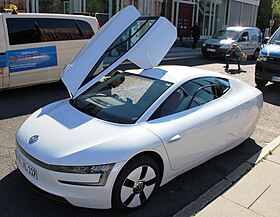| Volkswagen XL1 | |
|---|---|
 2015 Volkswagen XL1 | |
| Overview | |
| Manufacturer | Volkswagen |
| Production | 2013–2016 (250 Units) |
| Model years | 2015–2016 |
| Assembly | Germany: Osnabrück[1] |
| Designer | Klaus Bischoff, Thomas Ingenlath, Peter Wouda |
| Body and chassis | |
| Class | Subcompact car |
| Body style | 2-door coupé |
| Layout | RMR layout |
| Doors | Butterfly |
| Powertrain | |
| Engine | 800 cc TDI twin-cylinder, common-rail turbo-diesel 35 kW (48 PS; 47 hp)[2] |
| Electric motor | 20 kW (27 PS; 27 bhp) |
| Hybrid drivetrain | parallel Hybrid |
| Battery | 5.5 kWh lithium-ion battery[3] |
| Electric range | 50 kilometres (31 mi)[3] |
| Dimensions | |
| Wheelbase | 2,225 mm (87.6 in) |
| Length | 3,888 mm (153.1 in) |
| Width | 1,666 mm (65.6 in) |
| Height | 1,153 mm (45.4 in) |
| Curb weight | 795 kg (1,753 lb)[3] |
The Volkswagen XL1 (VW 1-litre) is a two-person limited production diesel-powered plug-in hybrid produced by Volkswagen. The XL1 car was designed to be able to travel 100 km on 1 litre of diesel (280 mpg‑imp; 240 mpg‑US), with a fully charged battery, while being both roadworthy and practical.[4] Without using electric, the XL is able to travel 100 km on 2 litres of diesel.[5] To achieve such economy, it was produced with lightweight materials, a streamlined body and an engine and transmission designed and tuned for economy. The concept car was modified first in 2009 as the L1[6] and again in 2011 as the XL1.[7]
A limited production of 250 units began by mid 2013 and pricing started at €111,000 (~ £119,000). The Volkswagen XL1 plug-in diesel-electric hybrid was available only in Europe and its 5.5 kWh lithium-ion battery delivered an all-electric range of 50 km (31 mi),[3] had a fuel economy of 0.9 L/100 km (310 mpg‑imp) under the NEDC cycle and produced emissions of 21 g/km of CO2.[8] The XL1 was released to retail customers in Germany in June 2014.[3]
- ^ "Know your VW factories: Osnabrück". Heritage Parts Centre. 18 September 2017. Retrieved 7 September 2020.
- ^ Cite error: The named reference
XL1specswas invoked but never defined (see the help page). - ^ a b c d e Torregrossa, Michaël (5 June 2014). "Le premier exemplaire de la XL1 livré en Allemagne" [The first unit of the XL1 delivered in Germany] (in French). Association pour l'Avenir du Véhicule Electrique Méditerranéen (AVEM). Archived from the original on 2 July 2014. Retrieved 7 June 2014.
- ^ "Volkswagen baut das erste 1-Liter-Auto der Welt" (in German). Volkswagen AG. Archived from the original on 18 February 2008. Retrieved 21 February 2008.
- ^ Cite error: The named reference
autoexpresswas invoked but never defined (see the help page). - ^ Jones, Benjamin (7 May 2008). "VW Confirms 1L Concept Will Become Reality in 2010". Archived from the original on 9 May 2008. Retrieved 7 May 2008.
- ^ "2014 Volkswagen XL1". Car and Driver. 14 June 2013. Retrieved 6 December 2018.
- ^ Cite error: The named reference
PriceVWXL1was invoked but never defined (see the help page).